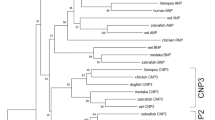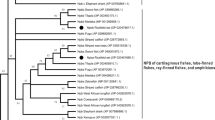Abstract
The natriuretic peptide (NP) family consists of cardiac NPs (ANP, BNP, and VNP) and brain NPs (CNPs) in teleosts. In addition to CNP1-4, a paralogue of CNP4 (named CNP4b) was recently discovered in basal teleosts including Japanese eel. Mammals have lost most Cnps during the evolution, but teleost cnps were conserved and diversified, suggesting that CNPs are important hormones for maintaining brain functions in teleost. The present study evaluated the potency of each Japanese eel CNP to their NP receptors (NPR-A, NPR-B, NPR-C, and NPR-D) overexpressed in CHO cells. A comprehensive brain map of cnps- and nprs-expressing neurons in Japanese eel was constructed by integrating the localization results obtained by in situ hybridization. The result showed that CHO cells expressing NPR-A and NPR-B induced strong cGMP productions after stimulation by cardiac and brain NPs, respectively. Regarding brain distribution of cnps, cnp1 is engaged in the ventral telencephalic area and periventricular area including the parvocellular preoptic nucleus (Pp), anterior/posterior tuberal nuclei, and periventricular gray zone of the optic tectum. cnp3 is found in the habenular nucleus and prolactin cells in the pituitary. cnp4 is expressed in the ventral telencephalic area, while cnp4b is expressed in the motoneurons in the medullary area. Such CNP isoform-specific localizations suggest that function of each CNP has diverged in the eel brain. Furthermore, the Pp lacking the blood-brain barrier expressed both npra and nprb, suggesting that endocrine and paracrine NPs interplay for regulating the Pp functions in Japanese eels.







Similar content being viewed by others
References
Amo R, Fredes F, Kinoshita M, Aoki R, Aizawa H, Agetsuma M, Aoki T, Shiraki T, Kakinuma H, Matsuda M, Yamazaki M, Takahoko M, Tsuboi T, Higashijima S, Miyasaka N, Koide T, Yabuki Y, Yoshihara Y, Fukai T, Okamoto H (2014) The habenulo-raphe serotonergic circuit encodes an aversive expectation value essential for adaptive active avoidance of danger. Neuron 84:1034–1048
Chou MY, Amo R, Kinoshita M, Cherng BW, Shimazaki H, Agetsuma M, Shiraki T, Aoki T, Takahoko M, Yamazaki M, Higashijima S, Okamoto H (2016) Social conflict resolution regulated by two dorsal habenular subregions in zebrafish. Science 352:87–90
Clasen RA, Pandolfi S, Hass GM (1970) Vital staining, serum albumin and the blood-brain barrier. J Neuropathol Exp Neurol 29:266–284
de Bold AJ (2011) Thirty years of research on atrial natriuretic factor: historical background and emerging concepts. Can J Physiol Pharmacol 89:527–531
Fitzsimons JT (1998) Angiotensin, thirst, and sodium appetite. Physiol Rev 78:583–686
Fowkes RC, McArdle CA (2000) C-type natriuretic peptide: an important neuroendocrine regulator? Trends Endocrinol Metab 11:333–338
Ganz J, Kroehne V, Freudenreich D, Machate A, Geffarth M, Braasch I, Kaslin J, Brand M (2015) Subdivisions of the adult zebrafish pallium based on molecular marker analysis. F1000Res 3:308
Greenwood AK, Wark AR, Fernald RD, Hofmann HA (2008) Expression of arginine vasotocin in distinct preoptic regions is associated with dominant and subordinate behaviour in an African cichlid fish. Proc Biol Sci 275:2393–2402
Hikosaka O (1991) Basal ganglia–possible role in motor coordination and learning. Curr Opin Neurobiol 1:638–643
Inoue K, Naruse K, Yamagami S, Mitani H, Suzuki N, Takei Y (2003) Four functionally distinct C-type natriuretic peptides found in fish reveal evolutionary history of the natriuretic peptide system. Proc Natl Acad Sci USA 100:10079–10084
Inoue K, Sakamoto T, Yuge S, Iwatani H, Yamagami S, Tsutsumi M, Hori H, Cerra MC, Tota B, Suzuki N, Okamoto N, Takei Y (2005) Structural and functional evolution of three cardiac natriuretic peptides. Mol Biol Evol 22:2428–2434
Ito S, Mukuda T, Ando M (2006) Catecholamines inhibit neuronal activity in the glossopharyngeal-vagal motor complex of the Japanese eel: significance for controlling swallowing water. J Exp Zool A Comp Exp Biol 305:499–506
Ito Y, Tanaka H, Okamoto H, Ohshima T (2010) Characterization of neural stem cells and their progeny in the adult zebrafish optic tectum. Dev Biol 342:26–38
Johnson KR, Olson KR (2008) Comparative physiology of the piscine natriuretic peptide system. Gen Comp Endocrinol 157:21–26
Kaiya H, Takei Y (1996a) Changes in plasma atrial and ventricular natriuretic peptide concentrations after transfer of eels from freshwater to seawater or vice versa. Gen Comp Endocrinol 104:337–345
Kaiya H, Takei Y (1996b) Atrial and ventricular natriuretic peptide concentrations in plasma of freshwater- and seawater-adapted eels. Gen Comp Endocrinol 102:183–190
Katayama Y, Wong MK, Kusakabe M, Fujio M, Takahashi N, Yaguchi M, Tsukada T (2020) Seawater transfer down-regulates C-type natriuretic peptide-3 expression in prolactin-producing cells of Japanese eel: negative correlation with plasma chloride concentration. Mol Cell Endocrinol 507:110780
Katayama Y, Saito A, Ogoshi M, Tsuneoka Y, Mukuda T, Azuma M, Kusakabe M, Takei Y, Tsukada T (2022) Gene duplication of C-type natriuretic peptide-4 (CNP4) in teleost lineage elicits subfunctionalization of ancestral CNP. Cell Tissue Res 388:225–238
Kawabata Y, Hiraki T, Takeuchi A, Okubo K (2012) Sex differences in the expression of vasotocin/isotocin, gonadotropin-releasing hormone, and tyrosine and tryptophan hydroxylase family genes in the medaka brain. Neuroscience 218:65–77
Kawakoshi A, Hyodo S, Inoue K, Kobayashi Y, Takei Y (2004) Four natriuretic peptides (ANP, BNP, VNP and CNP) coexist in the sturgeon: identification of BNP in fish lineage. J Mol Endocrinol 32:547–555
Kellner M, Diehl I, Knaudt K, Schüle C, Jahn H, Wiedemann K (1997) C-type natriuretic peptide exerts stimulatory effects on the corticotropin-releasing hormone-induced secretion of hormones in normal man. Eur J Endocrinol 136:388–393
Kishimoto I, Tokudome T, Nakao K, Kangawa K (2011) Natriuretic peptide system: an overview of studies using genetically engineered animal models. FEBS J 278:1830–1841
Kolosov D, Kelly SP (2020) C-type natriuretic peptide regulates the molecular components of the rainbow trout gill epithelium tight junction complex. Peptides (NY) 124:170211
Lessey AJ, Mirczuk SM, Chand AN, Kurrasch DM, Korbonits M, Niessen SJM, Mcardle CA, Mcgonnell IM, Fowkes RC (2023) Pharmacological and genetic disruption of C-type natriuretic peptide (nppcl) expression in zebrafish (Danio rerio) causes stunted growth during development. Int J Mol Sci 18(24):12921
Matsumoto A, Arai Y (1992) Hypothalamus. In: Matsumoto A, Ishii S (eds) Atlas of Endocrine Organs. Springer-Verlag, Berlin, Heidelberg, pp 25–38
Meek J (1983) Functional anatomy of the tectum mesencephali of the goldfish. An explorative analysis of the functional implications of the laminar structural organization of the tectum. Brain Res 287:247–297
Misono KS (2002) Natriuretic peptide receptor: structure and signaling. Mol Cell Biochem 230:49–60
Miyanishi H, Nobata S, Takei Y (2011) Relative antidipsogenic potencies of six homologous natriuretic peptides in eels. Zoolog Sci 28:719–726
Mueller T, Wullimann MF (2009) An evolutionary interpretation of teleostean forebrain anatomy. Brain Behav Evol 74:30–42
Mukuda T, Ando M (2003) Brain Atlas of the Japanese Eel: Comparison to other fishes. Memories Faculty of Integrated Arts and Sciences, Hiroshima University, Series IV 29:1–25
Mukuda T, Matsunaga Y, Kawamoto K, Yamaguchi KI, Ando M (2005) “Blood-contacting neurons” in the brain of the Japanese eel Anguilla japonica. J Exp Zool A Comp Exp Biol 303:366–376
Mukuda T, Ando M (2010) Central regulation of the pharyngeal and upper esophageal reflexes during swallowing in the Japanese eel. J Comp Physiol A Neuroethol Sens Neural Behav Physiol 196:111–122
Mukuda T, Hamasaki S, Koyama Y, Takei Y, Kaidoh T, Inoué T (2013) A candidate of organum vasculosum of the lamina terminalis with neuronal connections to neurosecretory preoptic nucleus in eels. Cell Tissue Res 353:525–538
Nakamori T, Chiba Y, Fujitani K, Makita A, Okubo T, Hirai K, Takamatsu N, Ohki-Hamazaki H (2019) Characteristic expressions of the natriuretic peptide family in the telencephalon of juvenile chick. Brain Res 1708:116–125
Nobata S, Ventura A, Kaiya H, Takei Y (2010) Diversified cardiovascular actions of six homologous natriuretic peptides (ANP, BNP, VNP, CNP1, CNP3, and CNP4) in conscious eels. Am J Physiol Regul Integr Comp Physiol 298:R1549–R1559
Potter LR (2011) Natriuretic peptide metabolism, clearance and degradation. FEBS J 278:1808–1817
Potter LR, Abbey-Hosch S, Dickey DM (2006) Natriuretic peptides, their receptors, and cyclic guanosine monophosphate-dependent signaling functions. Endocr Rev 27:47–72
Pouso P, Cabana Á, Goodson JL, Silva A (2019) Preoptic area activation and vasotocin involvement in the reproductive behavior of a weakly pulse-type electric fish, Brachyhypopomus gauderio. Front Integr Neurosci 13:1–11
Saito D, Komatsuda M, Urano A (2004) Functional organization of preoptic vasotocin and isotocin neurons in the brain of rainbow trout: central and neurohypophysial projections of single neurons. Neuroscience 124:973–984
Sakai N, Ohno H, Yoshida M, Iwamoto E, Kurogi A, Jiang D, Sato T, Miyazato M, Kojima M, Kato J, Ida T (2021) Characterization of putative tachykinin peptides in Caenorhabditis elegans. Biochem Biophys Res Commun 559:197–202
Saria A, Lundberg JM (1983) Evans blue fluorescence: quantitative and morphological evaluation of vascular permeability in animal tissues. J Neurosci Methods 8:41–49
Schulz S (2005) C-type natriuretic peptide and guanylyl cyclase B receptor. Peptides (NY) 26:1024–1034
Sellitti DF, Koles N, Mendonça MC (2011) Regulation of C-type natriuretic peptide expression. Peptides (NY) 32:1964–1971
Sellitti DF, Perrella G, Doi SQ, Curcio F (2001) Natriuretic peptides increase cAMP production in human thyrocytes via the natriuretic peptide clearance receptor (NPR-C). Regul Pept 97:103–109
Takei Y (2000) Comparative physiology of body fluid regulation in vertebrates with special reference to thirst regulation. Jpn J Physiol 50:171–186
Takei Y (2021) Evolution of the membrane/particulate guanylyl cyclase: From physicochemical sensors to hormone receptors. Gen Comp Endocrinol 315:113797
Takei Y, Takahashi A, Watanabe TX, Nakajima K, Sakakibara S (1991) A novel natriuretic peptide isolated from eel cardiac ventricles. FEBS Lett 282:317–320
Takei Y, Inoue K, Trajanovska S, Donald JA (2011) B-type natriuretic peptide (BNP), not ANP, is the principal cardiac natriuretic peptide in vertebrates as revealed by comparative studies. Gen Comp Endocrinol 171:258–266
Tsukada T, Nobata S, Hyodo S, Takei Y (2007) Area postrema, a brain circumventricular organ, is the site of antidipsogenic action of circulating atrial natriuretic peptide in eels. J Exp Biol 210:3970–3978
Tsukada T, Takei Y (2001) Relative potency of three homologous natriuretic peptides (ANP, CNP and VNP) in eel osmoregulation. Zool Sci 18:1253–1258
Uyama O, Okamura N, Yanase M, Narita M, Kawabata K, Sugita M (1988) Quantitative evaluation of vascular permeability in the gerbil brain after transient ischemia using Evans blue fluorescence. J Cereb Blood Flow Metab 8:282–284
Ventura A, Kawakoshi A, Inoue K, Takei Y (2006) Multiple natriuretic peptides coexist in the most primitive extant ray-finned fish, bichir Polypterus endlicheri. Gen Comp Endocrinol 146:251–256
Vernier P (2017) The brains of teleost fishes. Evolution of nervous systems. Elsevier, Netherlands, pp 59–75
Villalón A, Sepúlveda M, Guerrero N, Meynard MM, Palma K, Concha ML (2012) Evolutionary plasticity of habenular asymmetry with a conserved efferent connectivity pattern. PLoS ONE 7:e35329
Zempo B, Kanda S, Okubo K, Akazome Y, Oka Y (2013) Anatomical distribution of sex steroid hormone receptors in the brain of female medaka. J Comp Neurol 521:1760–1780
Zucker DK, Wooten GF, Lothman’ EW, (1983) Blood-brain barrier changes with kainic acid-induced limbic seizures. Exp Neurol 79:422–433
Acknowledgements
We thank Dr. Christopher A. Loretz of the State University of New York at Buffalo for critical reading of the manuscript and Dr. Naoyuki Yamamoto of Nagoya University for valuable advice on the fish brain anatomy.
Funding
This work was supported in part by JSPS KAKENHI Grants (nos. 20K06242 to TT, 20K15604 to YK, and 22K06291 to MW) and the Toyo Suisan Foundation.
Author information
Authors and Affiliations
Corresponding author
Ethics declarations
Ethical approval
This study was approved by the Animal Experiment Committee of Toho University. This article does not contain any studies involving human participants.
Consent to participate
Not applicable.
Conflict of interest
The authors declare no competing interests.
Additional information
Publisher's Note
Springer Nature remains neutral with regard to jurisdictional claims in published maps and institutional affiliations.
Supplementary Information
Below is the link to the electronic supplementary material.
Rights and permissions
Springer Nature or its licensor (e.g. a society or other partner) holds exclusive rights to this article under a publishing agreement with the author(s) or other rightsholder(s); author self-archiving of the accepted manuscript version of this article is solely governed by the terms of such publishing agreement and applicable law.
About this article
Cite this article
Izumi, T., Saito, A., Ida, T. et al. Paracrine and endocrine pathways of natriuretic peptides assessed by ligand-receptor map** in the Japanese eel brain. Cell Tissue Res 396, 197–212 (2024). https://doi.org/10.1007/s00441-024-03873-y
Received:
Accepted:
Published:
Issue Date:
DOI: https://doi.org/10.1007/s00441-024-03873-y




